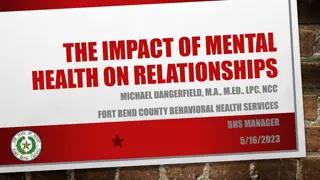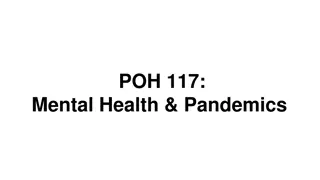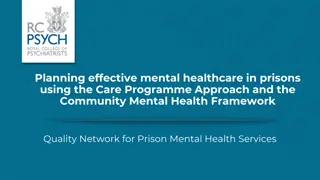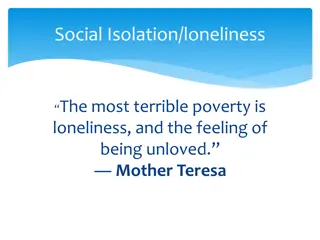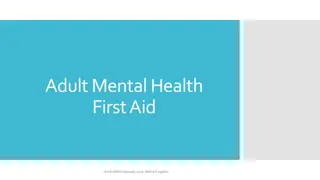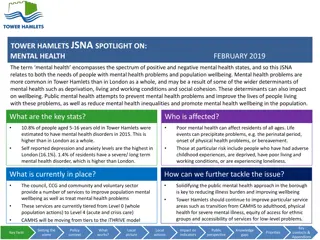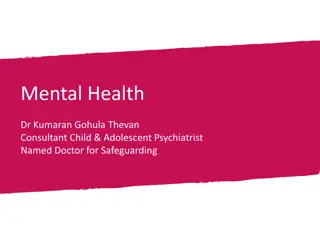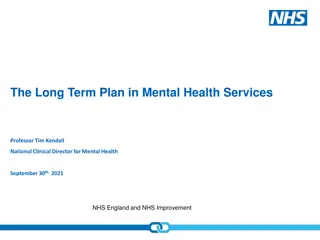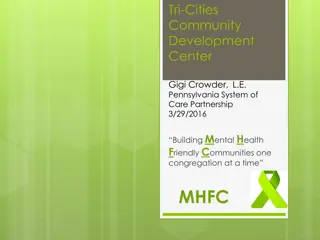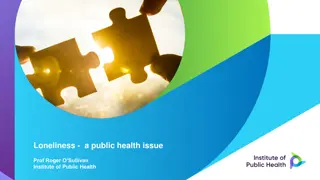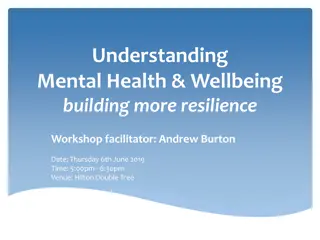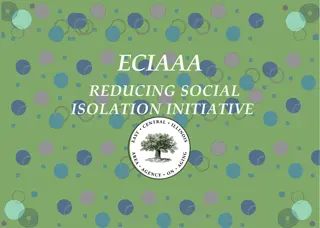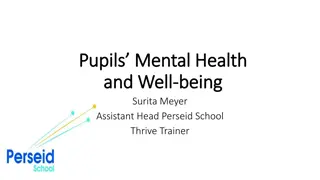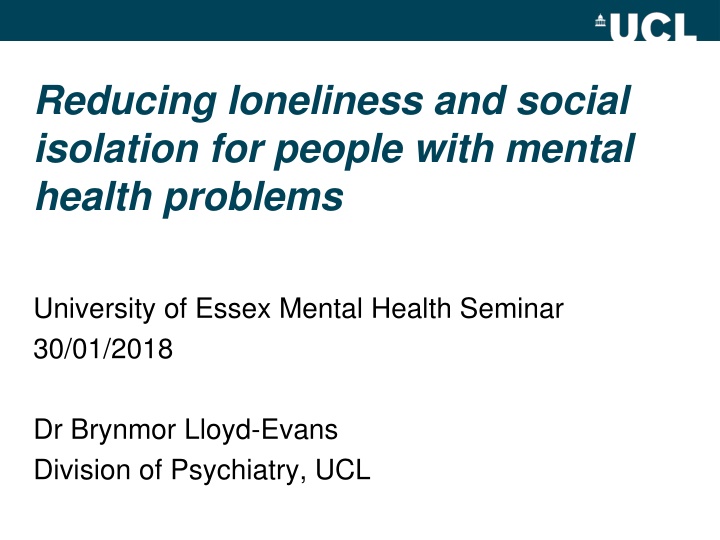
Strategies to Reduce Loneliness and Social Isolation in Mental Health Care
Explore insights from the University of Essex Mental Health Seminar on reducing loneliness and social isolation for individuals with mental health issues. Topics include the relationship between loneliness and mental health, interventions to address social isolation, and the impact of social networks on mental well-being.
Download Presentation

Please find below an Image/Link to download the presentation.
The content on the website is provided AS IS for your information and personal use only. It may not be sold, licensed, or shared on other websites without obtaining consent from the author. If you encounter any issues during the download, it is possible that the publisher has removed the file from their server.
You are allowed to download the files provided on this website for personal or commercial use, subject to the condition that they are used lawfully. All files are the property of their respective owners.
The content on the website is provided AS IS for your information and personal use only. It may not be sold, licensed, or shared on other websites without obtaining consent from the author.
E N D
Presentation Transcript
Reducing loneliness and social isolation for people with mental health problems University of Essex Mental Health Seminar 30/01/2018 Dr Brynmor Lloyd-Evans Division of Psychiatry, UCL
Todays presentation Loneliness and mental health: what do we know? The Community Navigators study: a feasibility trial of an intervention to reduce loneliness Social interventions in severe depression: an evidence gap or a treatment gap?
Social isolation Subjectively experienced loneliness Objective lack of social contact
The concept of loneliness Subjective gap between actual and desired levels of social relations (Perlman & Peplau 1981) Loneliness is moderately correlated with both depression and objective social isolation (Cacioppo 2013) but not synonymous Social and emotional loneliness are sometimes distinguished (DeJong Gierveld & Tilburg 2006) Validated measures of loneliness exist (ULS-8; DeJong- Gierveld-6)
Social isolation in people with mental health problems Loneliness 7-11% of general population may experience severe, chronic loneliness (Victor 2005, CGF 2016) Up to 40% for people with depression (Victor and Yang 2011) 10x odds of loneliness for people with MH problems (Meltzer 2012) Most research has focused on people with depression/anxiety often in elderly populations Social network General population: 6.5% severely isolated in UK (Banks et al, 2009) Typical number of friends: general population 7-11; people with SMI 3 (Palumbo et al 2016) Higher proportion of family members in social network for people with mental health problems (Buchanan 1995)
Reducing social isolation: what do we know? A variety of psychological and social interventions can increase social networks in mental health (Anderson et al. 2015) But their long-term sustainability is less clear Limited evidence about how to reduce loneliness (Masi et al. 2011) Promising social interventions have not been evaluated robustly Social prescribing (navigation and providing social groups) https://www.york.ac.uk/media/crd/Ev%20briefing_social_prescribing.pdf Connecting People programme https://connectingpeoplestudy.net/
Reducing loneliness in people with depression in secondary care: why is this a priority? Strong social determinants to depression in general Links between loneliness and poor recovery from depression are established (van Beljouw 2010, Holvast 2015) Limits to the effectiveness of medical and psychological interventions for severe depression But secondary care for depression and anxiety is often very medically and psychologically-focused: a need for more socially focused support? Care coordinators view social isolation as important, but rarely feel able to offer support with social connections (Pinfold 2014)
The Community Navigators Study 2-year study started March 2016 Funded by the NIHR School for Social Care Research Research Team from UCL and McPin 2 NHS Trusts (BEH and C&I) secondary services for people with depression or anxiety Aim: To develop and test the feasibility of a community navigator programme to reduce loneliness
Study team Study Leads Sonia Johnson, Bryn Lloyd -Evans (UCL) Co-applicants Vanessa Pinfold (McPin), Glyn Lewis, Jo Billings (UCL), Study Researchers Jessica Bone (UCL) Johanna Frerichs (McPin) Working Group 6 experts with lived experience 4 x practitioners 5 x study researchers
Structure of the Community Navigator study Developing a Community Navigator programme Development Preliminary testing with 10 service users Qualitative feedback from service users and navigators Initial testing Randomised controlled trial (30 service users receive support; 10 controls don t) Evaluation: quantitative questionnaires and qualitative interviews Feasibility trial
Following MRC guidance for developing a complex intervention Evidence review and consultation Modelling the intervention and theory of change CN study Testing feasibility and acceptability of the intervention Testing trial procedures and feasibility CN Study Multi-site RCT Replication and implementation studies Future studies
Developing the Community Navigation Intervention 8 meetings of a study stakeholder working group (experts with lived experience, clinicians, researchers) Consultation with experts in the field (WE, G4H, NDTI) Reference to relevant literature Intervention manual and theory of change model developed
The Community Navigator Programme Structure Key components Up to 10 sessions Up to 6 months 100 budget Additional group element Adding to standard care Training from study team/CDAT practitioners Supervision from MH service social workers Mapping my social world My connections plan G4H social identity building Solution-focused approach Help only with social contact/connections
Community Navigation: conceptual overlap with other interventions Intervention How is Navigation different? Befriending Focus on linking in, not doing with Mobilises existing social support Behavioural activation Focus on social contact (quality and quantity) not just activity Social identity programmes (e.g. G4H) Focus on 1:1 relationships as well as groups. Non-didactic approach Interpersonal Therapy (IPT) Focus on making new social contact as well as mobilising current network Simpler, non-psychological approach
Monitoring process and outcomes We will monitor how the intervention is delivered: How many sessions? Are mapping and goal setting done? What new activities or groups are accessed? And use outcome measures and qualitative interviews to explore mechanisms of effect: Social network Activity (time budgets) Social capital Depression
Community navigation case example: CI1 CI1: Now Meditation classes, Health Condition Group, Film Previously Sport and outdoors, volunteering, music Miss KCL Maybe City Farm Neighbourhood Centre Hit Volunteering Local film club Neighbourhood Centre film group Film Local football team Cricket club trips City Farm Sport TH Walking Group (new friend) Outdoors Adult Ed Recovery College Family plans Neighbourhood Centre (lunch club, film group > weekend trip with new friends) Social Reported impacts: More active, more confident More comfortable with others even if no point of connection (health condition) Finding interpersonal contact easier (e.g. brother-in-law)
Preliminary testing: qualitative feedback Overall really encouraging. Positives include: Navigators positive, friendly style Focus on social connections was valued even though it s scary Even small gains are appreciated Challenges Endings are difficult G4H group programme was not welcomed by many Need for good lines of communication with care coordinators
She wasn't in a rush to go. I could stay as long as you need me, which is nice in this day and age to have help. She was lovely, very, very kind. It has got me out and talking to someone and looking at what is around the local area that might be interesting, that I might like to do. There's more out there than you think. It s giving me encouragement to try and do it myself, but at the same time, I know that they are helping me out too.
Reflections from navigator case examples Navigators need to know the local community Individualised plans help Going with helps overcome initial barriers False starts will occur: a sustained, intensive focus is needed? Non-NHS groups led to informal contact/friendship Changes in thinking follow changes in behaviour
Next stage: Feasibility Trial RCT (n=40) Treatment group (n=30) receive CN support Control group (n=10) will be given a written list of local resources Baseline and 6-month follow-up Qualitative interviews with participants (n=20) navigators (n=3) and other stakeholders (n=10) Main outcomes Trial recruitment and retention Intervention integrity Acceptability and perceived usefulness
Outputs from the study A manual for the Community Navigators programme Clear ideas about the expected outcomes of the programme and how they will be achieved: a refined theory of change Tested procedures and outcomes to use in a future trial Preliminary evidence about the acceptability and usefulness of the navigator programme
A navigation approach: questions to answer.. Will people want this support? Will people identify as lonely? Will people be able to increase their social connections? Will increasing social contact address loneliness? Will it be too stressful for people?
Next steps If the programme shows promise in this trial.. A multi-site RCT with internal pilot Evidence about how to reduce loneliness and improve health outcomes for people with severe depression Bio Psycho Social?
The need for social interventions in severe depression Depression in general: Anti-depressant prescriptions have doubled in England over last 20 years: no change in the prevalence of depression (Spiers 2016) Unpromising evaluations of IAPT (Mukuria 2013) Treatment-Resistant Depression Little benefit from switching anti-depressants (NICE CG90) Limits to the effectiveness of CBT for TRD: (Wiles 2016: 46% (CBT) vs 22% (TAU) respond; fewer show complete remittance of symptoms)
Social determinants of depression Brown and Harris(1978) risk factors for depression in women: Unemployment Lack of a confiding partner 3 children under 14 Maternal loss before age 11 Low income, low education, unemployment, social isolation all subsequently associated with increased risk of depression in numerous studies (WHO 2014) Loneliness predicts the onset and poorer recovery from depression (van Beljouw 2010, Holvast 2015)
Social interventions for severe depression: Evidence gap or treatment gap? Employment support Family work Social isolation
Family interventions High expressed emotion predicts poor recovery in depression Relapse rates: 35% (low EE) vs 65% (High EE) EE is a stronger predictor of relapse in depression than in schizophrenia (Butzlaff and Hooley 2010) NICE recommends: Family Therapy for young people (CG28) Behavioural Couples Therapy (BCT) for TRD (CG90) BCT has the highest rates of recovery of all modes of therapy in high intensity IAPT settings (HSCIC 2016: Annual report on use of IAPT Therapies)
Employment Support IPS supported employment is highly effective for severe mental illness (studies often include severe depression) (Bond 2012) Evidence re IPS in common mental disorders is equivocal (Hellstrom et al 2017) But promising evidence that IPS + work-focused CBT helps employment and symptom reduction in depression, especially for the more severely depressed (Reme et al. 2015)
Social Isolation Effective treatments for symptom reduction in mild/moderate depression: systematic reviews support Befriending (Mead 2010) Peer Support (Pfeiffer 2011) Applicability to TRD populations are not established. Social prescribing approaches are increasingly popular in primary care, but lack robust evaluation (York CRD 2016)
Current provision of social interventions for TRD The local secondary care service for people with depression and anxiety in the area where I work does not provide: Behavioural Couples Therapy Specialist employment support Any programme in routine care to reduce social isolation Is this typical of secondary care services for people with severe depression? There are few specified service standards (e.g. compared to EIS services)
Improving outcomes in severe depression? Bio Psycho Social?
Thank you! For more information Study website: http://www.ucl.ac.uk/psychiatry/research/epidemiolo gy/community-navigator-study/ Or please contact: b.lloyd-evans@ucl.ac.uk

